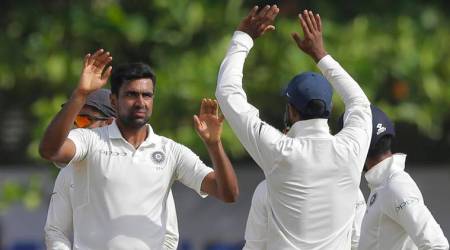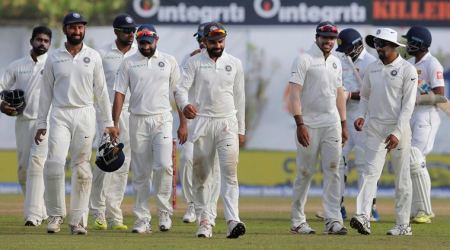 India captain Virat Kohli grins after Umesh Yadav dismisses Sri Lanka’s Dhanushka Gunatilaka for 2 on Day Four at Galle. (Source: AP)
India captain Virat Kohli grins after Umesh Yadav dismisses Sri Lanka’s Dhanushka Gunatilaka for 2 on Day Four at Galle. (Source: AP)
It was India’s biggest Test win abroad. Yet, it didn’t feel like one. No one scampered to pluck the souvenir stumps, it was an afterthought. No one swooped on Mohammed Shami, whose catch ended Sri Lanka’s fitful resistance. No one squealed or scowled, let alone burst into a delirious high-fives. The Indians celebrating their 304-run win and their 1-0 lead in the series resembled a bunch of orderly convent boys out on an excursion.
It was in sync with how the match had meandered on after Shikhar Dhawan’s breathtaking hundred. Not that the match crawled thereafter – both sides still batted at brisk pace and Virat Kohli scripted his 17th hundred – but it was considerably less thrilling, devoid of the customary ebbs and flows of Test matches in Galle. The fact that this was the weakest of Sri Lankan sides in the last two decades, further defected by unfortunate injuries to their batting tyro and their skipper, too needs at least a mention here.
It was also a sign of how the team has metamorphosed into a ruthless winning machine, at least in the subcontinent. That’s the reason such canters didn’t excite them any longer. The most definitive aspect of this win is that it was made to look routine. Even making things appear ho-hum is an art, and indicates how India has come up in leaps, since the last time they departed this idyllic port town.
This is a team that doesn’t blink in adversity, they have a man who puts up his hand for every occasion. The biggest difference, Kohli sees is how the team has begun to execute their plans methodically. The roles are defined and executed with a cutting-edge precision.
“At that time, it was more of talking a lot about plans and planning a lot about how to go a certain way against a certain player. Now I think guys are very comfortable with their skills and how they have to bowl and where they have to bowl and what fields they want. Also, you don’t need to necessarily tell someone how to bat or how to plan an innings. They understand,” he said.
No longer naive
To put it other words, they are no longer naive or dependent. If the Sri Lankans had applied fastidiously enough, they could have defied India to at least the end of fourth day. Mohammed Shami and Ravindra Jadeja embodied that meticulous execution of plans Kohli was raving about. The build-up to Sri Lankan opener Upul Tharanga’s dismissal by Sami was a classic case. He gave him a classical working over. He began the over with the one that angled away from him around the stumps.
He opens the bat phase for squeezing a boundary. The next is angled delivery straying into the pads. The next was the sucker ball-slanting in, a touch fuller, cajoling the batsman for the drive, then seaming away at the last moment, thus inducing the edge. It was a pity that Kohli spilled the catch. But Shami knew he had his man’s number. Two balls later, he angled one in outside the off-stump, before making it cackle back a shade to brush his inside edge. Tharanga sized up the angle, but didn’t account for the seam movement.
Jadeja’s deception was softer. Unlike Ravichandran Ashwin who took time to get a measure of the wicket, Jadeja had the wisdom to mix up the lengths. He would continuously bowl briskly at the stumps, before sowing the doubts with a slower, more flighted delivery that spat a little away. It was the continuous pressure he exerted on Niroshan Dickwella that prompted him to attempt a fatal sweep off Ashwin, which broke Sri Lanka’s last lingering hopes of stretching the match, and perhaps accomplishing a miraculous jailbreak.
Their purposeful batting would have, at least momentarily, concerned Kohli. For he has seen unseemly pairs taking the game away from India, like Roston Chase and Shane Dowrich in Kington, or Peter Handscomb and Shaun Marsh in Ranchi. But for a team progressively on the upward curve, they ensured such defiance don’t recur. Maybe, they didn’t show much emotions, but inwardly they have must have been relieved that the spooky ghosts of the past have been laid to rest.

